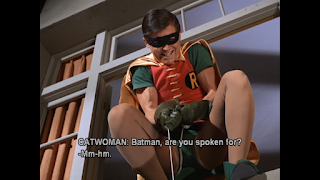Robin the Boy Wonder is the eager, youthful sidekick of Batman, the Caped Crusader, the vigilante crime-fighting alias of millionaire playboy Bruce Wayne. Introduced in 1940 as orphaned acrobat Dick Grayson in the DC comic book series Batman, Robin was played by Burt Ward in the 1966 television series on ABC.
As played by Burt Ward, Robin has a cute, boyish face, clean-cut, brown hair, and a compact, athletic physique which fits perfectly with his character's acrobatic background. His colorful outfit, with his dark green mask, gloves, and booties, his bright, red shirt, his shiny, yellow cape, his tight, green panties, and his form-fitting, flesh-color leggings, certainly catches the audience's attention.
Due to his youth, inexperience, and smaller size, the Boy Wonder is clearly the weak link in the Dynamic Duo, which their opponents often seek to exploit. Robin is also cocky, enthusiastic, and overly eager to prove his independent crime-fighting abilities, especially to Batman. He is often in trouble and in need of rescue.
This week's villain is Catwoman.
In the first episode, Batman and Robin are trapped in Catwoman's hidden playroom. While trying to cool off a scorching hot floor, the Caped Crusader breaks a pipe containing sleeping gas, rendering him and the Boy Wonder unconscious. Then, the Dynamic Duo are tied to two giant grills on the roof, under two giant magnifying glasses in the hot midday sun, where they are to be roasted to death.
In the next episode, Batman and Robin escape by readjusting the giant magnifying glass so that it burns their bonds, allowing them to free themselves.
Favorite shots:




















For fans of Robin peril, the second episode is one of the best.
The Dynamic Duo discovers that Catwoman intends to disguise herself as wealthy recluse Minerva Matthews and insert herself into a transaction with eccentric millionaire Zubin Zucchini involving the sale of two valuable violins for $500,000. They counter by replacing Zubin Zucchini with Robin in disguise. When Catwoman breaks her disguise and attempts to claim both the money and the violins, the Boy Wonder breaks his disguise and attempts to stop her.
However, Catwoman had a pair of her henchmen hide outside the window ledge, from which they emerge and quickly overpower the Boy Wonder. They resolve to throw the energetic, young, crime-fighter out the window.
In a moment of bravado, as his hands are being tied, Robin tells Catwoman that the police will be waiting for her in the lobby. Fortunately, the villainess has planned an alternate plan of escape.
One can safely assume that the primary reason why Batman decided to substitute Zubin Zucchini for Robin was to put the aging mogul out of harm's way. Inasmuch as the Boy Wonder believes that Catwoman plans to escape through the lobby, where the police would be waiting for her, the smart move would have been to keep up the disguise and let the plan run its course. His decision to break his disguise at this time was most probably motivated by a desire to apprehend the felonious female feline single handedly and claim the credit.
Fortunately, Catwoman's henchmen seemed to lack any truly murderous intent. Rather than quickly tossing the Boy Wonder out the window, they spend a lot of time swinging Robin back and forth playfully in front of the window, allowing his fans some nice views of his shapely legs, and, when Batman arrives and demands that they release the young sidekick, they comply.
During the subsequent fight, a gossip columnist chokes Robin with his bare hands, as he tries to push the Boy Wonder out the window.
Later, the opportunistic gossip columnist pushes Batman out the window, taking advantage of the fact that the Caped Crusader's back was turned, trying to save Catwoman, who was hanging from a rope out of the window.
Fortunately, Robin performs better in solo assignment this time. He manages to knock out the gossip columnist and finds Batman hanging from the same rope as Catwoman. The Boy Wonder's fans are then treated to a good shot of his tight, green panties, and form-fitting, flesh-color leggings as he works to rescue Batman and Catwoman from the hanging rope.
This blog is intended to promote the appreciation of Burt Ward's portrayal of Robin in the 1966 television series "Batman". You may purchase both episodes at the following link:
Previous blog:















































